Maha Kumbh Mela 2025 – A Divine Journey to Prayagraj
The Maha Kumbh Mela is not just a religious event; it’s an awe-inspiring gathering of faith, culture, spirituality, and humanity. Scheduled to take place in Prayagraj from January 13th to February 26th, 2025, this once-in-a-lifetime experience will draw millions of pilgrims, saints, and tourists to the sacred banks of the Triveni Sangam – the confluence of the holy rivers Ganga, Yamuna, and the mystical Saraswati.
The sheer magnitude of the Kumbh Mela makes it the largest peaceful congregation on Earth, a UNESCO-recognized Intangible Cultural Heritage, and an extraordinary expression of human devotion. But why is this event so deeply revered? Let’s explore the history, significance, and the unique experiences awaiting you at the Maha Kumbh Mela 2025.
The Mythological Roots of Kumbh Mela
The origins of the Kumbh Mela are rooted in Hindu mythology, specifically the story of the Samudra Manthan, or the churning of the ocean. According to ancient texts, both the gods (Devas) and demons (Asuras) desired immortality, which could be achieved by consuming the nectar of immortality (Amrita). When the nectar was found, a battle ensued between the gods and demons, and in the process, a few drops of the nectar fell upon four sacred locations on Earth: Prayagraj, Haridwar, Nasik, and Ujjain. These cities have since become the venues for the Kumbh Mela, and it is believed that bathing in their holy waters during the Kumbh cleanses one of sins and brings the soul closer to salvation.
Prayagraj, in particular, is considered the holiest of these sites because it is home to the Triveni Sangam, where three powerful rivers converge. This natural confluence is said to hold special spiritual significance, making the Maha Kumbh Mela in Prayagraj a once-in-a-lifetime opportunity for millions.
Kumbh Mela’s Astrological Significance
The timing of the Kumbh Mela is determined by a specific alignment of the sun, moon, and Jupiter in the astrological calendar. For the Maha Kumbh Mela in 2025, this alignment will occur over the course of 45 days, from January to February, with key bathing dates known as Shahi Snan (royal baths), which are regarded as the most auspicious times for pilgrims to immerse themselves in the sacred rivers.
The 2025 Shahi Snan dates are as follows:
- Paush Poornima: 13 January 2025
- Makar Sankranti (First Shahi Snan): 14 January 2025
- Mauni Amavasya (Second Shahi Snan): 29 January 2025
- Basant Panchami (Third Shahi Snan): 3 February 2025
- Achla Saptami: 4 February 2025
- Maghi Poornima: 12 February 2025
- Maha Shivratri: 26 February 2025
These dates are considered the most spiritually charged moments during the Kumbh, where pilgrims believe a single dip in the waters washes away sins and purifies the soul. Among these, Mauni Amavasya is the most revered, attracting the largest crowds as it is considered the holiest day of the festival.
The Kumbh Experience: More Than Just a Bathing Ritual
The Kumbh Mela is much more than just taking a holy dip in the rivers. It is a cultural spectacle and spiritual retreat rolled into one. The Mela offers an opportunity to witness ancient Hindu rituals, attend enlightening discourses by sages, and be part of processions where Naga sadhus (naked ascetics) lead the way in their royal splendor.
- The Sacred Dip: Millions of pilgrims flock to the banks of the Triveni Sangam to perform the sacred ritual of bathing in the river. For devotees, this act symbolizes washing away their sins and attaining Moksha (liberation from the cycle of rebirth). The experience is often described as both transformative and purifying.
- Sadhus and Saints: One of the highlights of the Kumbh Mela is the presence of Hindu monks, ascetics, and gurus who come from remote parts of the country. The Naga sadhus, with their ash-covered bodies and long dreadlocks, are perhaps the most iconic figures of the Kumbh. These holy men renounce all worldly possessions, live austere lives, and are revered as spiritual leaders.
- Spiritual Discourses: The Kumbh is also a forum for spiritual learning, with pravachans (discourses) delivered by prominent Hindu scholars, saints, and religious leaders. These sessions provide insights into Hindu philosophy, offering guidance on leading a righteous and meaningful life.
- Processions and Pageantry: The grand processions of saints, sadhus, and their followers add a festive vibrancy to the Kumbh Mela. These colorful parades are accompanied by chanting, music, and celebrations, creating a mesmerizing atmosphere of devotion and joy.
- A Global Phenomenon: What makes the Kumbh Mela unique is the diversity of its attendees. While it is predominantly a Hindu festival, people from all walks of life, from different countries and religions, participate in the event, making it a global confluence of faith and humanity.
Exploring the Rich Heritage of Prayagraj
While attending the Maha Kumbh Mela in 2025, visitors have the opportunity to explore the ancient city of Prayagraj, which is steeped in history and spirituality. Here are some of the must-visit places during your trip:
- Triveni Sangam: The confluence of the Ganga, Yamuna, and Saraswati rivers, where pilgrims gather to take the holy dip.
- Akshayavat: A sacred banyan tree believed to be immortal, located within the Prayagraj Fort.
- Patalpuri Temple: A subterranean temple within the fort that holds historical and spiritual significance.
- Alopi Devi Temple: A revered Shakti Peeth, where devotees seek blessings from the goddess.
- Bade Hanuman Mandir: A unique temple dedicated to Lord Hanuman, featuring a reclining idol of the deity.
- Prayagraj Fort: A grand fort built by Emperor Akbar, offering stunning views of the Sangam and a glimpse into India’s Mughal history.
For those seeking day trips from Prayagraj, the nearby cities of Varanasi, Chitrakoot, and Ayodhya are filled with spiritual landmarks and ancient temples, adding further richness to your Kumbh Mela experience.
Planning Your Trip: Accommodation, Transport, and Safety
The Maha Kumbh Mela attracts millions of visitors, so planning is crucial to ensure a smooth and fulfilling experience. Accommodation options range from basic tented camps along the riverbank to hotels in the city. It’s advisable to book early, as demand is exceptionally high.
For those traveling to Prayagraj from Delhi, Varanasi, or other nearby cities, taxi services like India Taxi Online provide convenient transport solutions. Booking a reliable taxi or private car will ensure you have a comfortable journey to and from the festival site.
Additionally, the local administration takes extensive measures to ensure the safety and security of pilgrims. Medical facilities, lost-and-found centers, and helplines are set up throughout the Mela grounds to assist visitors.
Conclusion: An Experience of a Lifetime
The Maha Kumbh Mela 2025 in Prayagraj is a profound spiritual journey, a meeting point of faith and culture, and an unforgettable experience for anyone seeking inner peace and connection to the divine. Whether you are a pilgrim seeking spiritual enlightenment or a traveler eager to witness one of the world’s most extraordinary human gatherings, the Kumbh Mela offers an experience that transcends boundaries and unites humanity in its quest for meaning and salvation.
Prepare for an adventure that promises not only a glimpse into the heart of India’s spiritual heritage but also the opportunity to take part in one of the oldest, grandest, and most meaningful festivals in the world.


One Reply to “Maha Kumbh Mela Prayagraj”
February 28, 2025